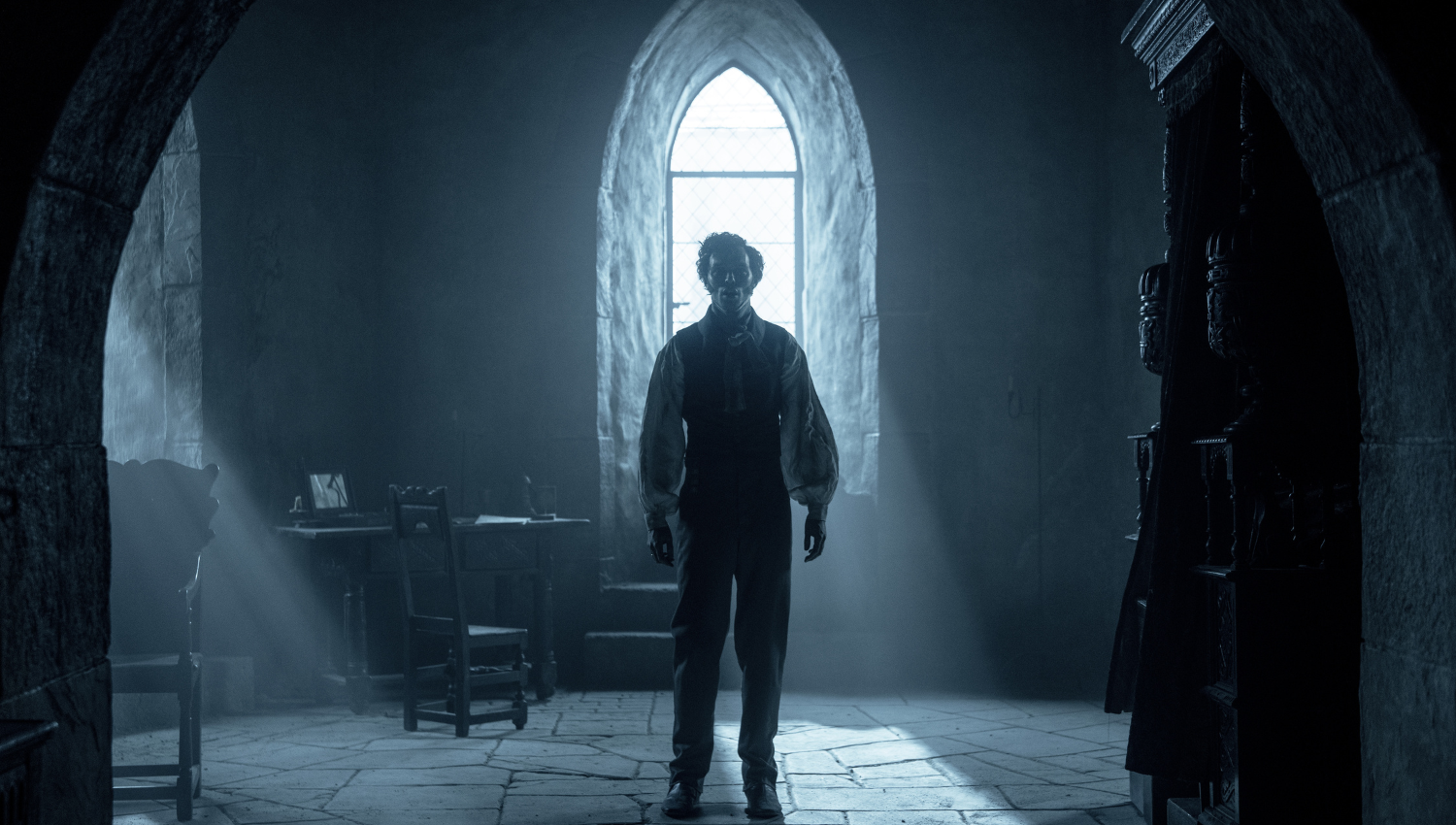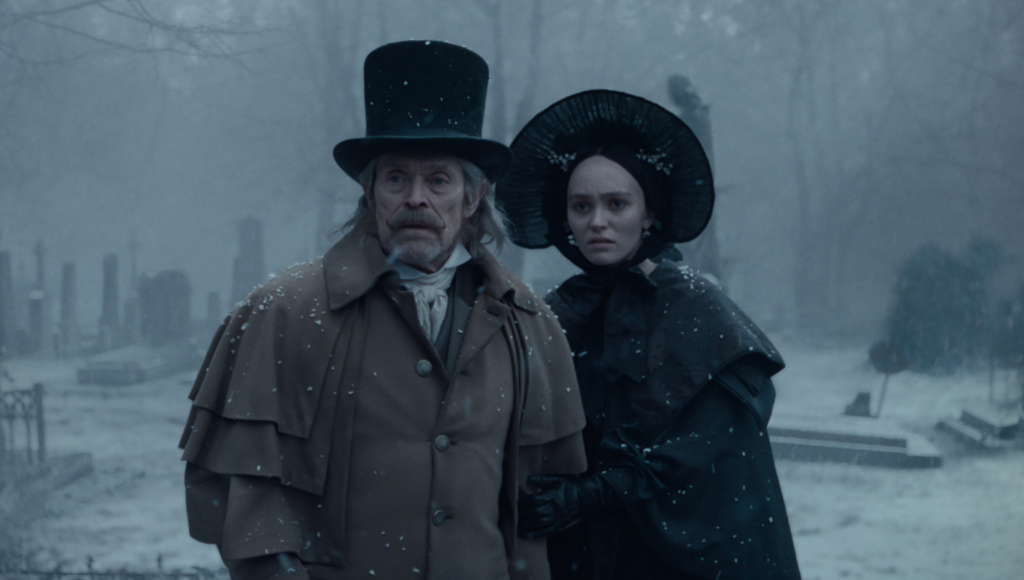
Nosferatu
Mark White
Sometimes, there is a simple convergence of many elements that lead to the creation of perfection; this convergence is so rare that it becomes almost a requirement to revel in the revelation of such perfection when it happens. And this holiday season – may the Yuletide sentiment be damned – that convergence of perfection goes by a familiar, terrifying name: Nosferatu.
In 1838 in Wisborg, Germany, Ellen and Thomas Hutter (Lily-Rose Depp and Nicholas Hoult), a recently married couple, are on the cusp of major changes in their lives. Thomas is looking for the next major promotion in his job with the real estate agency run by Herr Knock (Simon McBurney) in order to secure a more financially prosperous future for himself and Ellen. Herr Knock is very eager to give Thomas the chance to prove himself with a real estate deal requiring an in-person sale and signature at the request of a very wealthy man with an old bloodline in the Carpathian foothills of Transylvania. Thomas makes haste to set out and meet with the aforementioned mysterious Count Orlok (Bill Skårsgard) and sell him a property just outside of Wisborg, while Ellen is besieged with the terror – physical, waking convulsions – over the fear that someone will kill Thomas in Transylvania and come to Wisborg for her next…someone that she has seen in her dreams – for years. Thomas’ journey and Ellen’s dark past are set to unleash a ghoulish nightmare not only on their marriage but on the people of Wisborg as the truly demonic and foul Count Orlok searches for blood…and twisted companionship.
For those well versed in cinema history or the horror genre, rest assured that the well-known story remains wholly intact as a very blatant (and wildly unauthorized) adaptation and manipulation of Bram Stoker’s Dracula; what can – and should be said – about Eggers’ remake is that it is, in a word, a MASTERPIECE. Yes, there is blood. Yes, there is a nod to the now infamous Last Voyage of The Demeter, and oh yes, Eggers gleefully gives us shadowy shapes of the vampire that would make Murnau’s expressionist film proud. All of the required Dracula/Nosferatu set pieces and moments are present, but much like the monster’s ornate coffin, it is the dark unholy content within that truly matters, and Eggers aims to expose it to the moonlight .

Eggers’ event-faithful script delves deep into feminist territory by bravely ripping into any lace-and-corset ideas of the chaste and fragile female class of the period and allows us all to see Ellen as a woman with sexual desires and unfulfilled needs of intimacy and understanding; Ellen is not merely an object to be won or fought for, but a fully-formed and complex person with a deeply seated need for love in all its facets, so much so that she willingly – albeit without fully understanding – invites and prays for the love of an unseen presence to enter her life as a blossoming woman…the result being the undead Orlok appearing and taking a small piece of her soul, promising to claim her completely some day. The interaction between a virginal Ellen and a disembodied Orlok begins as shy and eerily tender as a first encounter might be, until Orlok’s true decaying visage and presence is revealed and Ellen is subject to the horror of her union with the demon. From that moment – a well executed jump scare to be sure – Ellen is cursed with Orlok’s presence in her dreams. She is burdened with visions on events before they happen, possessed by violent seizures – all haunted by Orlok’s voice, always promising by the impending reunion between the two. Eggers’ audacity in granting sexual agency for Ellen and allowing her to express desire, as twisted as it becomes, is bold – not just for the time period the film lives in, but for a ‘beauty and the beast’ horror film as well; so often the role of the woman, as either prize or damsel, has male sexuality and conquest thrust upon them as a pretty vessel, but Eggers allows Ellen to be aroused, lonely, to express longing, and even possess a dark curiosity to return to the embrace of the monster that haunts her. Allowing a woman to express herself may not be as revolutionary as it sounds, but in a period horror piece that still wants the audience to cower before the presence of the undead vampire lord, letting the heroine be this complex and human, especially with her body, is so refreshing, elevating the stakes of the story; Ellen may or may not like the hell she has awakened, and the audience must hold on tight while she tries to determine which it is for herself.
And then there is Thomas, a man also ‘of the period’ whose struggle with stoicism and the labels of masculine success is so tightly wrapped around him that he is rendered almost void of life; a man who is willing to make a Faustian deal with a terrifying and mysterious stranger in a damp castle in order to secure financial success and be seen as a proper husband to his wife and family. Thomas’ willing eagerness to venture into danger in the name of securing his masculinity, blindly working for – and being fed on – by Orlok, is simultaneously part classic hero journey and part scathing indictment of the male dominated status quo. Thomas is forced by his status as a man to recklessly walk into danger, and in order to maintain his job – a key definition of his masculinity – he stays with Orlok to straighten his affairs for the real estate and becomes a victim, both of societal expectation and the ruthless vampire lurking in the dark.
This sensual, sinful, suspenseful remake amps up the disturbingly romantic and rotting underbelly of the vampire sub-genre, cementing Eggers as a horror maestro and expert filmmaker and elevates Lily-Rose Depp to a scream queen.
All of this – the complex struggles of Ellen and Thomas – leap from Eggers’ pages onto the screen thanks to the sublime subtextual work of Depp and Hoult. Both actors get moments – alone and together – to showcase specific physicality that adds color to what could easily be recreations of stock characters of the genre. Depp, fearlessly exposed at times and possessed with total abandon at others, always returns to an aching mixture of attraction and trembling fear to the voice that haunts her; Hoult, as a counterbalance to Depp’s plight, shows flickers of terror, rage, anguish and conflict as he tries to assume the mantel of the hero, but is met with his wife’s dark secrets…and the horror of being Orlok’s blood bag. Depp’s work is extreme and the most expressive – and most likely to garner attention – but the understated duress and conflict in Hoult’s turn underlines the agency in Depp’s Ellen, and makes their relationship challenging, turbulent, sexy, and fragile. Even if one has seen the previous iterations of Nosferatu and knows how the story ends, Depp and Hoult play with the inner workings of the characters so much that the script becomes tense and full of suspense, leaving the ending that looms feeling dangerous and uncertain.
Of course, special mention is reserved for Skårsgard and his Orlok. A cavernous baritone, rumbling and raspy, his tongue sledgehammering sounds with blunt force, Skårsgard creates a distinct sound for Orlok that is delightfully dreadful, his breathing hissing as if his lungs are full of holes. Skårsgard’s voice is merged with a very original look for the infamous Nosferatu; instead of the prolonged features like the long ears and hooked nose, Skårsgard’s monster is a decaying lord of the manor – muscles and anatomy missing, eyes frosted and dead, the only part of him still living is his finger nails, eerily thick and grey. The look is nightmarish and effective, and when lit in profile, Skårsgard’s posture and hands create the iconic shadow of the monster that birthed the horror genre. It is a testament to Skårsgard’s talent and fearless approach to extreme monsters that he can – once again – disappear into a monstrous role and create something that stands out; his Orlok may be a step below his Pennywise for sheer looks, but the terror generated here stands toe to toe with the shapeshifting clown.
Eggers has been working on a remake of the silent era vampire film since 2015, after the success for his first feature The Witch propelled him to the forefront of the indie horror scene. What was meant to be his next feature suddenly gave way to The Lighthouse, followed thereafter with The Northman. But Eggers ‘passion project’ finally came to fruition after years of research, writing, fine-tuning and exploration, and it arrives in all the resplendent gothic fanfare and terror that one could hope for in an Eggers film. In standing back and looking at his brief but impressive filmography, it is gleefully apparent that his previous three features taught him the tools needed to pull of what he does here in Nosferatu: his mastery of natural lighting in outdoor settings – especially at night – as well working with period language in The Witch enhances the wintery night of Nosferatu, throwing shadows and chilling all colors captured on lens to bring realism and mood; his production design work paired with the unique monochrome of and frame size of The Lighthouse informs the old school camera work and set designs (lots of old European location work) that brings the gothic world of Wisborg to life seamlessly; and the sheer size and scale of The Northman exposed Eggers to modern CG work and a much larger budget to work with, teaching a talented up-and-comer how to build an epic project and keep his aesthetic while learning to appreciate the new.
The end result…is the convergence of many elements that lead to creating perfection. Eggers keeps the film faithfully old-fashioned while bringing a modern understanding of messy, complex humanity to a simple monster story. This nightmare is sexually awake – and hungry – all while terrified of the idea that we, like Ellen, may enjoy the idea of being corrupted; Eggers’ film reveals how we can terrified of what our desires may bring, or like Thomas, might cost us to obtain. Eggers’ reverence for the time period, as well the legacy of the original Murnau feature, while determinedly endeavoring to find the sexual power and terror between the three central characters, lifts every theme and idea to dizzying heights in a film that utterly terrifying and wondrous to behold. Eggers’ Nosferatu is an icy but erotic reminder that base instincts can clash with our minds – our morality – and that this struggle is an undeniable truth of the human experience; giving this struggle the horrifying shape of the terrible count – especially as envisioned by Eggers – jars us awake, turns us on as it repulses us, and challenges us to look at ourselves for a moment and be honest about what we value, and what those things may bring to us, or take away from us. To do all of that in a delicate arrangement of candlelight, lace, snow, and copious amounts of blood, is tremendous accomplishment for the icon that is Nosferatu, for the genre, and for Eggers and his ensemble.
Final Thought
If the guilds and boards (and the Academy) can overcome their horror bias, this film could upset the awards race; outside of that, Nosferatu may just be the best horror film of the year.
